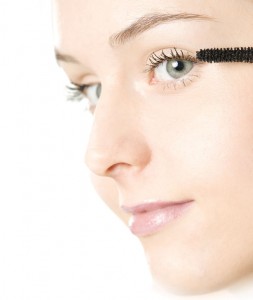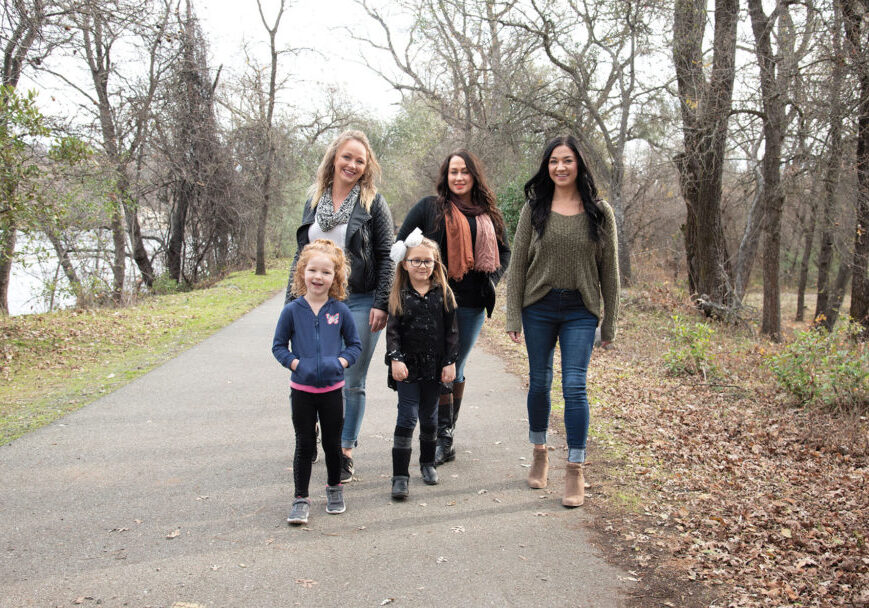 Last March celebrity tabloids were abuzz when toddler Vivienne Jolie-Pitt was spotted wearing lipstick in public. Observers were decidedly focused on the appropriateness of the 3-year-old’s “dress up” demeanor. Noticeably absent were comments about the health risks of exposing a child so young to potential lead contaminants contained in the lipstick.
Last March celebrity tabloids were abuzz when toddler Vivienne Jolie-Pitt was spotted wearing lipstick in public. Observers were decidedly focused on the appropriateness of the 3-year-old’s “dress up” demeanor. Noticeably absent were comments about the health risks of exposing a child so young to potential lead contaminants contained in the lipstick.
More recently Broadway and television actress Kristen Chenoweth admitted in an interview with CNN anchor and talk show host Anderson Cooper that she had suffered a severe allergic reaction to the glue she used to apply eyelash extensions. It turned out that glue contained formaldehyde, a chemical the U.S. Department of Health and Human Services has classified as carcinogenic.
Are these examples unusual? Surprisingly, the answer is no. Last November the State of California sued the makers of hair smoothing product Brazilian Blowout for failing to warn consumers that it also contained formaldehyde. The company was fined and forced to change its advertising. Yet a few months later, a Good Morning America hidden camera investigation of salons that sold the product revealed all failed to notify consumers of the risk.
Cosmetics, Personal Care Products and Consumer Safety
Many may be surprised to learn that the personal care products used by women, men and children, ranging from lipstick and aftershave to deodorant, toothpaste and baby shampoo, contain chemicals that have been linked with allergies, learning disabilities, reproductive harm and cancer.
“We’ve seen a huge increase in many diseases that really fuels a lot of the concern about chemical exposure,” says Stacy Malkan, Communications Director of the Campaign for Safe Cosmetics and author of Not Just a Pretty Face: The Ugly Side of the Beauty Industry.
Ten years ago Malkan and Charlotte Brody, who then both worked for Healthcare Without Harm, joined Women’s Voices for the Earth and the Environmental Working Group (EWG) to begin researching cosmetics after a Center for Disease Control study discovered a higher concentration of chemical phthalates in women’s lab tests.
According to EWG, phthalates are a group of toxic industrial chemicals used both to make plastics more flexible and as solvents in an array of consumer products, including deodorant, fragrances, hand lotion, shampoo and soap.
“More than 70% of cosmetics contained phthalates but the chemicals weren’t listed on the label,” says Malkan. “That was the first clue that there was a lot going on with personal care products that we didn’t know about.” They pulled together a coalition of health and environmental groups, headed by the Breast Cancer Fund, and founded the Campaign for Safe Cosmetics. Funded by individuals and foundations, the Campaign does not accept contributions from companies, thereby allowing it to remain independent.
Shannon Coughlin, Communications Director of the Breast Cancer Fund says, “We’re concerned about lead in lipstick, but also about chemicals like parabens and phthalates that have been linked to breast cancer.” Malkan adds, “An important part of preventing cancer is getting carcinogens out of the products we put on our bodies.”
Cosmetic Safety in the National Spotlight
On March 27, Congress convened its first hearing in 30 years on the safety of cosmetics and personal care products, largely
in response to public pressure over highly publicized cases involving consumer health risks.
In 2011 Representative Jan Schakowsky (D-IL) and others introduced the Safe Cosmetics Act. Malkan says the legislation would force manufacturers to eliminate chemicals suspected of causing cancer or reproductive harm while also requiring full disclosure of a product’s ingredients. Additionally, it would establish a system of safety assessments under the Food and Drug Administration
(FDA) to study the health effects of chemicals being used by cosmetics labs and allow the FDA the same recall authority for cosmetics that it currently possesses for food and drugs.
It is not surprising that counter legislation has been proposed to offset the perceived threats of regulatory changes to a $50-billion-a-year industry. Malkan says a second bill, the Cosmetics Safety Enhancement Act, would grant the FDA recall authority but lacks the safety standard of Schakowsky’s bill, eliminating the requirements to ban carcinogenic ingredients or disclose those ingredients to consumers.
A third competing bill, expected to be introduced soon, is backed by the cosmetics industry and seeks to put into law decisions made about cosmetic ingredient safety by the industry-funded Cosmetic Ingredient Review Panel.
Until the legal loopholes are closed, many potentially hazardous products remain on store shelves.
Consumer Action and Advocacy
Consumers are not without recourse. “The first thing people can do is simplify,” says Malkan. “Use fewer products with fewer chemicals, especially on kids.” Research conducted in 2009 by the Campaign for Safe Cosmetics found carcinogenic ingredients in dozens of bath products for babies and children, including the industry giant, Johnson’s Baby Shampoo. A 2011 follow-up study revealed Johnson’s had reformulated its shampoo and was distributing a safer product in some countries but not in others, including the United States and Canada.
Second, Malkan recommends avoiding synthetic fragrances, noting that companies hide behind a “trade secrets” argument to prevent disclosing chemical additives. Some, like phthalates, are especially problematic for men, causing reproductive harm. Choosing products that are fragrance-free or scented with essential oils are safer options.
Third, she suggests using EWG’s Skin Deep database (http://www.ewg.org/skindeep) to verify the safety of ingredients in over 60,000 personal care products. The database ranks those products on a scale from one (least toxic) to ten (most toxic).
Fourth, beware of unsubstantiated marketing claims. “There aren’t any legal standards for words like natural, organic, or hypoallergenic,” says Malkan. “You need to look at the label and do some research to find the best products.”
Finally, Malkan says “We can’t just shop our way out of the problem. We have to put laws in place to hold the industry accountable to making safe products.” To that end, the campaign website safecosmetics.org suggests a number of ways consumers can get involved, from letter-writing campaigns and grassroots activism to making safe cosmetic and personal care products at home.
Simple ideas for making better choices about what goes on your skin
by Alyssa (Aly) Evirs
1. When in doubt, ask questions!
If harmful cosmetic ingredients are a concern for you, arm yourself with pen and paper while shopping. Write down questionable ingredients and research them at home or ask an expert for information before purchasing.
2. Realize that natural is not always gentle!
It is a misconception that “natural” means gentle or less aggressive. Many natural ingredients found in cosmetics, especially skin care products, are designed to be very active ingredients and effective at creating desired changes in the skin. If you are looking for natural ingredients because you feel your skin or body is sensitive, make sure to still seek out products designed specifically for sensitive skin.
3. Expensive does not always equal better, but cheap usually does equal cheap!
Just because a cosmetic or beauty care product is expensive does not mean it’s better for you or more natural than a lesser-priced product. Today organic, high-quality, sustainably sourced ingredients are much more readily available. Many natural, safer products can be found at an affordable price. But buyer beware … really cheap “natural” products may be misleading consumers about the actual quantity of natural ingredients in the product itself. Any reputable natural beauty company will be transparent when it comes to the quality and quantity of their ingredients.
# # #
Writer Alyssa Evirs is owner of Boheme Salon and Spa in Redding, CA, and is passionate about safe cosmetics and skin care products.
Posted in: Health & Nutrition
Comment Policy: All viewpoints are welcome, but comments should remain relevant. Personal attacks, profanity, and aggressive behavior are not allowed. No spam, advertising, or promoting of products/services. Please, only use your real name and limit the amount of links submitted in your comment.
Comments
Leave a Reply
You Might Also Like...

Pack Pain: Backpack Safety for Back to School
Kids everywhere will head back to class this fall with their own unique sense of fashion on display. Whether students sport a message tee, cargo shorts or a school uniform, […]

The Subtlety of Heart Disease in Women
Heart Disease is Often Subtle in Women Know the Signs, What to Do, and How to Prevent It The leading cause of death among women in the United States is […]

Managing Yourself in Time
One of my mentors, Bill Truby, taught me the following: “We don’t need to learn time management because we simply can’t manage time.” He said, “The reality is that there […]

Surviving and Thriving on a Single Income
Life is expensive. Life with kids is even more expensive. According to Pew Research, 31 percent of families live on a single income. Although many families make the choice, others […]




R.M.C. says
The potential for chemical reform is quite exciting, but it should be done in a way that doesn’t take the lives of millions of animals (for toxicity testing) in the name of better protection for human health and the environment – and to bring the latest lipstick shade to the market. Legislative language should be explicit and ban animal testing for cosmetics and cosmetics ingredients. We need to ensure that chemical testing is in line with the 21st century and relies on modern, human cell and computer-based methods that provide accurate data on how a chemical acts and what the impact on human health may be.